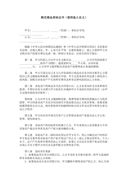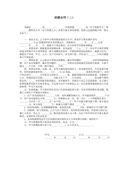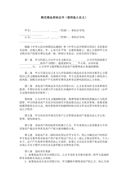新课标Unit 3 第3课时(通用12篇)七年级英语教案
新课标Unit 3 第3课时(通用12篇)
新课标Unit 3 第3课时 篇1
第三课时 (sectionb 1a----2b)
step ⅰ、game
1、 把挂图挂在黑板上,给学生三分钟时间,四人一组。
2、 拿下画,要求学生尽可能多地写出画上所学过物品的单词。
3、 每组选出一名代表朗读所记下的单词。
4、 哪组记得单词最多,哪组获胜。
step ⅱ、
1、 小组操练句型 where is the book?
it’s on the desk。
2、 打开书本,完成1a
step ⅲ、listening
听录音,完成2a、
step ⅳ、listening
将听力内容展示出来,学生耕读录音
step ⅴ、
学生单独完成2b,然后核对答案。
新课标Unit 3 第3课时 篇2
课题
unit5 section a (2b---4b)
教 学 目 标
1、知识目标 thank ,do ,tim ,sonia ,jane
2、能力目标: 培养学生根据情景说出实物的名称,并看到实物能用英语进行自由交际的能力。
3、情感目标:通过探究学习,培养同学们的团结合作精神,认识到团结合作的重要性
自 学 提 纲
1、用游戏的形式复习上一节课的新单词和句型。将所要复习的单词物品放入一个袋子中,让学生伸手去摸,由一个学生或全班学生发问,该学生猜。所用的句型是:
— what’s this in english ?
— it’s a/an …
— how do you spell that?
— … 2 listen and check the things you hear . 3 listen again ,and complete the conversation with words in the box.。
4 ask and answer
1)、以小组为单位,做2b的对话练习。
2)、口头检查学生所练的对话。
5. listening
1)、听对话,圈出p10—1a中的物品。
2)、再听一遍,写出单词。 6 用学过的单词练习新句型 a:what’s this in english ? b: it’s a pen . a: how do you spell it ? b: p-e-n . 7 用同样的方法练习新的句型。 8. games
老师收集一些学生的学习用品,请学生到前边来发问,找到用具的主人,给两次机会。
补充内容
自 学 提 纲
9 the alphabet
1)、纠正26个字母的读音,学唱新的字母歌。
2)、请学生将26个字母下面标上阿拉伯数字,练习数字1—26的说法。
10. practise
再进行一个游戏。一个学生看p94,另一个学生看p98。根据图片所显示,进行问答练习。
达标测试
1 listen and complete the sentences . 1)is this your _________? 2)no,it __________? 3)that’s __________book . 4)thank you .it’s his _________. 5)can you spell _______? 2 根据问题,圈出正确的答案 1)how do you spell pencil ? a it’s a pencil b it’s not a pencil c p-e-n-c-i-l 2)what’s that in english ?a it’s not a pen b it’s a key c no,it’s not my key . 3) is this his ball ? a yes ,it’s his ball b no,it’s a ball c yes , it’s my ball . 4) what’s this ?a yes ,it is b no,it’s a pen c it is a pen .
教 学 反 思
1.学生表现出极高的热情,要及时表扬鼓励,尤其11班机个平时不太好发言的同学,都积极举手表演对话,看来及时地表扬与鼓励对学生的恶学习会起到很好的效果。学习竞赛形式的出现对学生亦是一种无言的鼓励。
新课标Unit 3 第3课时 篇3
课题 (period 4 :section b 3a, 3b, 2, 4)
教 学 目 标task 1:(知识点)学习五个元音字母,并能根据这五个元音字母给26个字母归类。task 2:(重点) 将所学的26个字母按顺序朗读、默写2.复习字母a-z,及一些相关的表达方法.明确元音字母与辅音字母的分类。task 3:(难点/易混点): 按音素划分字母:将所学的26个字母按顺序朗读、默写对初学者来说是比较容易做到的。但如果将26个字母按音素划分是比较难的事情。教师从一开始教字母时,就应该让学生在朗读时去感受不同字母之间所含有的相同元音音素。尤其是字母f,l,m,n及r的归类。
自 学 提 纲stepⅰ revision and warming-upcolors can make colors.2. 3a: listen and repeat.stepⅱ presentationt:a、e、i、o、u 这五个字母我们称它们为元音字母。read and remember them a-e-i-o-u, a-e-i-o-u.s: a-e-i-o-u, a-e-i-o-u(check individual student by saying or writing.)step ⅲ listen and read the chantsection b 4:﹡focus attention on the chant lyrics. explain that they are about to hear a chant with these lyrics.﹡play the chant the first time. students just listen and follow the lyrics in their books.﹡play the instrumental version of the chant. this time, students chant along with the tune. step ⅳ gamesgame1-巧排方阵 answers: game2招兵买马t: a-e-i-o-u they are five captains. the others are soldiers. please find your own captain. let’s see which team is the fastest.(give each student a letter card, students who get a,e,i,o,u are captain. they should stand in front of the class. the other students should find their own captain and stand in his line.) 五个元音字母aeiou是司令,其它字母是小兵(按字母发音归类) aa 司令的小兵是 hh, jj, kk. ee 司令的小兵是 bb, cc, dd, gg, pp,tt,vv. ii 司令的小兵是 yy. oo 是一个光棍司令.uu 司令的小兵是qq,ww.〔e〕 是一个假司令,它的小兵是 ff, ll, mm, nn, ss, , zzrr是一个流浪兵。 stepⅴ listen and repeat.section b 2:﹡focus attention on the chart. read aloud the words in the top row. get ss to repeat. check pronunciation and correct if necessary. make sure ss understand the difference between the two “a” sounds.﹡repeat for the next rows.﹡ss listen and repeat.stepvi look up the vocabulary.t:look up these words in the vocabulary index.(pencileraser,dictionary,green,morning,color,hello,boy,girl.)教师请学生在课本生词表里查出该词,并举手说出词义。看谁查得又快又好。然后教师请查得最快的同学来介绍查单词的方法和步骤。stepvii summary
新课标Unit 3 第3课时 篇4
课题
section a: 2a-4
教 学 目 标1. 复习家庭称呼单词.2. 学习新句型: is she\he your friend\aunt..? yes, he\she is. no, he\she isn’t.3. 区分:is this jim? yes, it is. no, it isn’t.are these your brothers? no, they aren’t
自 学 提 纲1 复习以小组竞赛形式复习单词,即将上节课所学词汇写在纸条上,背面朝上,让每组同学依次轮流认读,根据读对的单词数及所用时间评出优胜组。2 2a.1). 领读单词。2).听录音,圈出所听到的单词3. 2b 1).放录音,找人物,2).解释录音内容,并跟读录音。3). 检查答案。4. 2c小组活动,完成任务。5. 3a1) 认读四个单词。2) 小组活动,完成3a,3) 检查并讲解:is this jim? yes, it is. no, it isn’t. 其中的 it is 不能缩写为it’s, 而否定答语中可以缩写为it’s not或it isn’t.注:若主语是these, those 时,答语必须用they来代替。补充内容
自 学 提 纲6. 总结1. uncle , aunt 是一组对应词,当后面接姓时,首字母须大写,如:uncle li, aunt zhang等。记住以下的对应词:father---mother brother---sister, grandfather---grandmother, son---daughter, boy---girl, man---woman, husband---wife.2. is this jim? yes, it is. no, it isn’t. 其中的 it is 不能缩写为it’s, 而否定答语中可以缩写为it’s not或it isn’t.注:若主语是these, those 时,答语必须用they来代替。如:are these your brothers? no, they aren’t.达标测试
教 学 反 思1. 学生是活动的主体,课堂上大部分的时间交给学生,教师的引导是关键。如何一层层的导入,由易至难的阶梯状任务何时引入,如何引入都是关键所在。同时要注意的是,学生活动之前的范例一定要明确清晰,要每个孩子都知道做什么和怎么做,活动才会顺利的开展,学生才能在活动中有所得。本课中的教学任务能体现这一点。2. 在课堂设计上体现任务型教学的主导思想,以任务贯穿教师教学和学生活动的各个环节。学生活动的目的明确,每个步骤教师都给出了活动所需的语言知识内容,学生亦能准确的使用目标语言,在活动中学习掌握知识。3. grammar focus处理尚欠妥当。以培养学生综合语言运用能力为根本目的的英语课堂“采用活动途径,倡导体验参与”。这并非摈弃一切传统的教学方法。我们要吸收传统教学法的优点,给学生使用语言的机会,也给学生注意语言形式的机会。在教学中,要注意引导学生重视grammar focus这一环节。
新课标Unit 3 第3课时 篇5
课题
section b:1-2c
教 学 目 标 1. 了解家谱及家庭成员的关系 2. 制作家庭——学校联系册
自 学 提 纲 1. play a guessing game. 每组推选一人上台,用布将他/她眼睛蒙上,其它组任选四人上前问候(hi/hello)。其余学生问:who's this?让他/她猜is this?ss: yes, it is./no, it isn't.可猜三次,猜中小组得1分并继读猜。猜错,退下。 2. family tree1. 1) ask a student to read the family words shown on the family tree. 2) ask ss to write the correct word from the box on each of the blank lines. then check the answers. 3. 2a. play the recording the first time. ss only listen. then play again, ask the ss to listen to the conversation and place a checkmark next to each family member mentioned. check the answers together. 4. 2b. listen again let the ss to tell which picture are dave and lin hai talking about. 补充内容
自 学 提 纲 5. 学生制作自己家的family tree,并加以评比展示。 6. 制作家庭——学校联系册,老师将表格发给学生,让学生两人一组询问对方并填写下表 然后两人交换并带回家,家长核查(予以一定的纠正), 然后再将表格交给老师,老师评阅、定等级并将调查表装订成“家庭——学校联系册”,以方便学校与家庭的联系。
members
name
age
job
telephone number
's father 达标测试 基础训练:p22,2、3
教 学 反 思 1. 任务的设计不应仅限于课堂,而应延伸到课堂之外的实际学习和实际生活之中,故布置的作业可适当扩展课堂任务,如制作自己家的family tree。制作家庭——学校联系册等。另外,引导学生注意培养预习能力。 2. 课堂教学形式以学生活动为主体;能关注学生的情感,整个过程要以激励评价为主,以评价促学生发展。
3. 由于新时间紧,对任务型教学研究还很不够,学生在做汇报的时候,如何让全体学生用心去听,是一个急需重视的问题。
新课标Unit 3 第3课时 篇6
课题
my name’s gina(section a 1a-1c) 教 学 目 标
1 .认知目标.词汇:mary, gina, jim ,jenny ,your ,her, his, name, nice ,to you, meet , you, sentences :what’s your name ?my name is/name’s /i’m …,hello. i’m mary. hi, mary, i’m ….nice to meet you .
2.能力目标:
培养学生的口语交际能力及听力,运用what’s your name ?询问别人的名字,用my nameis…向别人介绍自己。
3.情意目标:
鼓励学生运用英语进行对话,在交际中,克服害怕出错,或害羞的心里,大胆开口积极参与小组活动。
自 学 提 纲
step one revision
1. greet with the students by using “good morning/ good
afternoon/ hello/ hi…”
revise “what’s this in english? what color is it?” by
showing some lovely toys.
step two lead in
师生问答: t:what’s your name?
s1:my name is li xunyang.
t: nice to meet you.
s1:nice to meet you ,too.将这些句子板书
step three pairwork
get the students to ask and answer in pairs. teacher gives them help indeed.
step four 1a
1. divide the class into groups of four. ask them to look at the picture in 1a for about two or three minutes , first list the words as many as possible and then share with group members.
2. memory challenge. ask some groups to make a report to see which group has the most words. meanwhile the teacher writes some easy and important words on the blackboard.
3. give the students a few minutes to copy the words on the books.
3. show some pictures of boys and girls and teach the new words of the boy’s name : alan, jim ; the girls’ names : mary, jenny, gina.
step five listen and number
1. look at 1b and ask some pairs to read the conversations.
2. play the recording for the first time. students only listen.
3. play the recording a second time. students number the conversations.
4. check the answers.
5. get the students read the conversations and
recite them.
step six pair work
1. say the conversations in 1b, substituting the names of students in the class. have students repeat.
2. ask the students to practice the conversations in 1b with a partner. tell them to use their own names.
1. 任务一:结识新朋友。 老师首先向学生做一个自我介绍,将名字写在黑板上: my name is …, my first name is…, my last name is …同时介绍一下名字的意义,然后学生就近组成若干小组,进行自我介绍。
2. 制作姓名卡。制作姓名卡,由小组协作共同完成姓名卡的设计与制作,姓名卡中要求包括学生的汉语名字(拼音书写)和英文名字,其他的内容由各组自行设计,但要求每个人的姓名卡的设计要有创意、体现小组的共性、美观大方、经久耐用、语言准确。因此,该任务既体现个性,又体现共性;既有分工,又有合作。
自 学 提 纲 homework 1.抄写本节课的新词汇每个三遍。 2.recite 1b
3.homework
为自己、父母、亲朋好友找一个有意义的英文名字,同时将他们介绍给你的同学们。
达标测试
一. 词汇
cl___ck n__ce y__r
二. 完成句子。
1. 你姓什么?what’s____ name?
2. 我叫mary。____ mary./ my ____ mary. my name ___ mary
3.见到你很高兴。___ to ____ you.
教 学 反 思
本节课的设计体现了任务型教学的特点,同时整个任务链的设计均以学生的兴趣 为主,由易至难,逐层递进,逐步完成各个任务,使学生在愉快的完成每一个任务的同时,体会到学习英语的乐趣,并使每一位学生都参与到活动中,都有所提高。
本节课由于是新学期的第一节课,在教学中,本着 “新学期、新起点、新观念、新
认识”的观点设计了四个快乐的任务,同时这几个任务相互连接,环环相扣,形成了一个完整的任务链。整节课课堂气氛活跃,学生学习英语的兴趣始终很浓。尤其是“找朋友”这个任务,极大地调动了学生的积极性,学生们说出了很多精彩的句子,。而在制作姓名卡时,各小组通力合作,氛围和谐,作品各具特色,体现了任务型教学中共同合作与个性张扬的优势。在解释自己名字的任务中,充分调动了学生的表现欲,学生们的名言经整理后被保留下来,提高了学生学习英语的积极性。
在各国礼仪表演中学生既学到了英文知识,又了解了其他各国各地的风俗,将知识“延伸到课堂之外的学习和生活之中”。因此,这节课中的活动具有可操作性,并以学生的生活经验和兴趣出发,使学生的思维和想象力、审美情趣得到发展,从而提高学生实际语言运用能力。 另外,本节课的德育目标,使英语教学与其他学科结合起来。
本节课中也存在几个需要继续探索的问题:
一、师生均是初次接触任务型教学,对其仅是好奇及尝试,尚未能领会其主旨。
二、活动中课堂秩序稍有些乱,在以后课堂中应加以指导。
教师本身也需要提高对新课标和任务型教学的认识,以完善今后的教学。
新课标Unit 3 第3课时 篇7
课题
section a 1a-———1c
教 学 目 标
1、确认家庭成员,能用英语表达家庭成员:mother father brother sister grandfather grandmother parents friend this that these those
2、 运用句型this is……, that is……, these are……,those are……介绍他人。
3、拼写单词:mother father brother sister parents friend this that these those
自 学 提 纲
1、复习
1)利用图片、实物,通过what's this in english? how do you spell……? is this/that……句型,复习pencil, pen, book, eraser, pencil case, backpack, pencil sharperner, dictionary, notebook, key, watch
2、学习生词
1) 出示一张一家三代照片, 示范句子this is his mother/ father/ sister和生词:mother,father, sister并板书this is ……及mother,father, sister
2)学生听教师说句子,理解含义,跟读生词:friend,mother,grandfather,parent, brother, grandparent
30 利用实物 区分this that these those 和these /those are ……
3、1a看课本1a中的图片,将图中家庭成员的字母代号与所给单词配对,然后检查答案。
4、1b 让学生看课本1b,仔细看1a中的大图片,认真听录音,圈出图中男孩所谈论的人物。认真观察大图片,抓住关键的信息要素 5、1c 教师活动:让学生看课本1a中的图片,先复习家庭成员的单词,运用句型: t:this is his…… that is his……these are……those are…… 依次谈论dave's family, 完成1c的练习 。让学生先读单词,然后两人进行口语活动,补充内容
自 学 提 纲6.区分 am is are 用法 i am a student . you are a student. he is a student she is a student it is a pencil.达标测试1、写出下列单词: 1.父亲 2。 母亲 3。姐姐 4。弟弟 5。 祖母 6。外祖母 7。 朋友 8.父母 9、 这些 10、那些 2、 用is 和are 填空 1) this is a book.2) _____ that your ruler?3) what ___these ?4) what color _____ those pens?
教 学 反 思
本节课有两个教学难点,单词的学习记忆和this,that ,these,those 与is,are运用。因为大多数学生在学习本课之前单词,已经基本会读。所以及时指导学生如何记忆单词至关重要。
1、grand 是一个前缀,表示亲属关系中的 “(外)祖…” 或 “(外)孙…”之意。grand + son--- grandson(外) 孙, grand + daughter----granddaughter(外)孙女等。
2、friend 单词i 不发音。
3、利用顺口溜教学is are 与this that ,these,those等词的连用,
“我是am,你是are;is 连着他、她、它。单数is,复数are。”
4、及时补充练习。
新课标Unit 3 第3课时 篇8
课题
unit5 is this your pencil ? (1a ----2a )
教 学 目 标
1、知识目标:1 . 利用实物教学单词:pencil ,book, eraser, case ,pencil case ,backpack, pencil-sharpener ,dictionary , 2 用已学的单词教学新句型:is this / that your ….? yes, it is .it is my …… no, it isn’t .it’s his /her ……
2、能力目标:根据场景询问英语中对应的表达法;
3、情感目标: 通过探究学习,培养同学们的团结合作精神,认识到团结合作的重要性。
自 学 提 纲
1、老师可利用实物进行教授单词,让学生完成match的任务,然后订正答案。 值得注意的是:假如学生在小学没有学习过这些英语单词,他们将根据什么来完成老师布置的这一任务?也许会做 对几个,或许有什么小窍门,我们可以让学生分析以下他们的思考过程,进而加以归纳,对有贡献的学生加以鼓励及表扬。我想这就是对学生学习方法或策略的指导,学生定会非常喜欢。 2、朗读1a中的新单词。(先是全班,然后分小组检查、补漏)。 3、听录音,完成1b的听力练习,然后订正答案。 4、跟读对话,以小组为单位朗读对话。(互相检查、帮助)。
补充内容
1. warming-up:: good morning. my name is …. what’s your name? s: good morning. my name is …. t: nice to meet you. s: nice to meet you, too. 2. 讲授1a中的新单词。老师可利用实物进行教授单词,使用的句型是: what’s this in english?(此时,只需学生能够理解该句型,不必会说,老师多次的重复是为学生下一节课掌握提供大量的语言输入做准备)这一步是针对一般学校来设计的,如果好一点的学生,我们可以直接进入1a,让学生直接完成match的任务,然后订正答案。 3.、朗读p7—1a中的新单词。 4、听录音,完成p8—2a的听力练习,然后订正答案
自 学 提 纲
5、进行小组对话练习,可以更改有关的词,编出自己的对话。
6、给学生3—5分钟的时间,准备新单词和句型。 7 再听对话,完成书上要求标号的任务,订正答案。
homework. 说明:可以适当布置一些笔头作业,但是,目的在于练习书法,而不是为了背单词。所以,不应太多,应把学生的精力放在多听,多读,记忆单词和句型上。(因此老师可以根据不同的学生类型进行布置作业。)
达标测试
1、listen and circle the things you hear .把你听到的物品圈出来。 2、根据问题,选出正确的答案。1)is this his ball ? a yes, it’s his ball .b no, it’s a ball. c yes ,it’s my ball. 2)is this a dictionary ? a yes, it is. b yes ,it’s a book . c no, it’s a dictionary . 3)what’s this ?a yes ,it is . b no, it’s a pen . c it is a pen . 4)what’s that in english ?a it’s not a pen .b it’s a key . c no, it’s not my key .
教 学 反 思
1. 学习者的参与与语言熟练程度关系很大。所以课上是十分重要的,我们应抓住学生在课上的每一分钟,将学生吸引到听英语、讲英语的活动中来,从而达到在最短的时间内提高对所学内容的掌握的熟练程度。 2. 充分调动学生学习英语的主观能动性,要做好学生的思想工作
新课标Unit 3 第3课时 篇9
课题 section b 1a-4
教 学 目 标1、知识目标: 1..熟练掌握词汇:pen key ruler quilt map orange jacket in english。 2熟练掌握确认事物的一般句型。3.掌握如何拼某个单词。4.对元音字母的发音进行归类。2、能力目标: 通过学习使学生掌握如何拼某个单词,并掌握一些基本的日常交际用语。 3、情感目标: 通过拼记单词,锻炼学生的记忆力,为今后掌握教广泛的英语交际打下坚实的基础。
自 学 提 纲 step1.revision 1. 1. revise letters we’ve learnt. 2.ask and answer with the students like this:t: what’s this in english?s: it’s a /an…. step2.lead in1.call attention to the picture. read the dialogue and ask students to repeat: a: what’s this in english? b: it’s a key. a: spell it, please. b: k- e- y.2.play the recording for the students to listen and repeat. step3.practice 1. get the students to practice the conversation in pairs like this : a: what’s this in english? b: it’s a/an… a: spell it, please. b: … 2.do 2a. let the students write down the words. step4.listening 1. focus attention on the words. ask the students if they can remember these items. 补充内容1. 1. 教师利用字母卡片与学生一起复习字母.2. 2. 利用实物做道具复习句型. 学生利用实物分组练习. 找学生到黑板上写出单词,集体纠正。
自 学 提 纲3. play the tape for the students to listen and write the numbers on the lines according to the order. step5.pairwork 1. draw attention to the picture. read the dialogue and ask students to repeat. 2. ask the students to practice the conversations in pairs. step6. listening play the recording for the students to listen and circle the letters. step7. pairworkdo3b. get the students to fill in the missing letters. step8. listen and repeat make sure students understand the difference between the vowel sounds. 达标测试 见基础训练p8 e.vi. viii.
新课标Unit 3 第3课时 篇10
第四课时
stepⅰ、revision
1、 复习本单元句型和单词
⑴ 单词:听写,同桌之间互相批改。
⑵ 句型:利用方位词就人的身体部位编写对话。
如:s1:where is your mouth?
s2:it is under the nose.
step ⅱ 3a,3b
学生独立完成,核对答案。
step ⅲ game
1、 拿出一个baseball,先叫一位学生走出教室。叫他的同桌把球藏起来。
2、 走出教室的学生找寻baseball,并与其同桌编写对话。
3、 更换物品与学生,操练4至5次。
step ⅳ writing
1. 根据文字描述出事物的位置,然后将自己的图片与书上的图片相对照。
2. 划出表示位置关系的短语。
3.我的理想房间
1. 通过幻灯片向同学展示几种不同的设计风格,为了充分挖掘学生的英语潜力,我们希望学生用简短的句子、短语甚至单词谈谈他们的感受,喜欢的原因。eg: i like the second picture because it is very bright and tidy.
2. 在看过很多漂亮的房间设计方案后,学生自己也会产生一定的想法。引导学生设计属于自己的房间。他们可以使用自己最喜欢的颜色,并放置学生最喜欢的家具。为了他们生活的方便和舒适,还可以发挥自己的想象力在自己的房间里增加许多设施。然后按照自己的设计思路画出房间的设计图纸,可以图上适当的颜色或是作出适当的标识。
3. 在设计图纸上配以简短的问题说明自己的设计思路,特别是表示位置关系的各种物品的位置。
4. 课上请一部分同学展示自己的作品。然后组织同学在课后将设计作品展示在教室内,同学们可以相互评比最终选出一个最佳方案。
5. 通过幻灯片向同学展示几种不同的设计风格,为了充分挖掘学生的英语潜力,我们希望学生用简短的句子、短语甚至单词谈谈他们的感受,喜欢的原因。e.g. i like the second picture because it is very bright and tidy.
step ⅴ、
reading
阅读“just for fun”
新课标Unit 3 第3课时 篇11
课题
my name’s gina. section b(1a—2c)
教 学 目 标
1、知识目标:词汇zero, one two, three, four, five,six,seven,eighr, nine .telephone, phone,phone number, 句子:what’s your phone number? it’s…
2、能力目标:
掌握数字的读写,并且能用数字表达电话号码。听力能力不断提高。
3、情感目标:
关心同学,了解他人,大胆用英语交际,提高兴趣,学会合作,学会创新。
自 学 提 纲
step one revision
play the game:
a:my name’s tony.
b:his name’s tony. my name’s linda.
c:her name’s linda. my name’s nick
d:his name’s nick. my name’s …
step two competition
1. 1a.intruce the numbers 0-9
play the recording for the first time, ss only listen, then repeat them and write them on the books. learn to spell them.
2. teach them english song<ten little indian boys>
3.1b. play the recording for the first time. ss only listen. then write the phone numbers.
step three listening exercise
1.bill: what’s your telephone ___,tony/
tony: it’s _________.
bill:2-7-8-6-9-2-6.____.
2.2a. point to the numbered list of names. read each one aloud along with the number that comes before it. play the recording while ss listen, then play them again to get ss write the letter of each telephone in the blank after the person’s name.
one by one to repeat the conversations according the power point pictures.
step four pair work
point out the address book headings names and phone numbers, then get them in groups of four, and have them ask and complete the chart.
step five homework
1. write the numbers for three times
2. 调查3个朋友的电话号码。
补充内容
1. make id card. they can add some information as a real id card. then, make their own id card in groups. show students the teacher’s id card on the computer.
2..check the telephone number from 114. one student is the operator, others can check the telephone number by asking : “what’s ’s telephone number?” ask the students to do it,and tell them the rules
达标测试
一. 用英语完成下列数字:
_ne, t__o, thr__, f__r, f_ve, s_x, s___ v__n ,__igh_, n__ne.
二.写出下列各句的答语。
1. a:what’s your phone number ?_b:______________.
2 a: what’s your first name?_ b:___________
3 .a: nice to meet you. b:_______________.
4 a:. hello, i’m mary. b:______________________.
教 学 反 思
本节任务型课程的设计比起第一节课的内容,有一定难度,知识量、信息量都增加了.例如:英语和汉语中姓与名的区分就是一个难点,在以后的课程中仍需要进一步加以区分。整个任务链的设计仍然以任务教学为主要的依据,同时遵循教学的规律,各个任务以学生的兴趣为出发点,高潮迭起,做到“乐而学,学而乐”。
本节课设计的游戏是模仿114查号台,该任务利用上一个任务整理后的班级电话簿去查询,它要求每一位学生都要投入角色,尤其是作为话务员,要求声音甜美、温和,态度和蔼。其实施过程是由一个学生作为话务员,其他学生可以任意拨通电话并且询问:“what’s ’s telephone number?”,同时话务员回答:“ his/her telephone number is …”。这项任务的设计主要是为了在任务活动中练习让学生脱口而出0—9这几个英文数字,同时,这项任务活动的过程中所用到的句型what’s ’s telephone number?和his/her telephone number is …中,his和her 是对上一节课形容词性物主代词的一个复习,而“ ’s telephone number”对于本单元在内容上是一个补充和提高。学生学得惟妙惟肖,做到了“活动要以学生的生活经验和兴趣为出发点,内容和方式要尽量真实;活动要有利于学生学习英语知识 ,发展语言技能,从而提高学生实际语言运用能力”。最后制作身份证的活动,学生将所学知识与实际生活相结合,积极发散思维,制作适合他们并且证明他们是一个成人的证件,这一点符合学生到初中之后希望他们周围的人能够用成人的眼光来看待自己。同时,本节课的作业是一项具有延伸性和拓展性的作业,也是写作的一次尝试。
总之,这节课的任务设计我认为还是比较成功的,基本达到预先的想法。但是,它也存在以下几个需要继续探讨的问题:
第一、在建立班级电话簿的任务中显得时间较为仓促,调整本课时间安排。
第二、在制作身份证的过程中,个别学生的动手能力稍差,导致任务未完成,需考虑小组互助。
新课标Unit 3 第3课时 篇12
课题
my name’s gina(sectionb3a-just for fan)
教 学 目 标
1 .认知目标. 词汇:card, id card, family, family name. 句子 :what’s her telephone number? what’s her family name? what’s her first name? 2.能力目标:复习本单元的交际用语,培养学生运用英语对话的能力。 3.情感目标:培养学生的口语交际能力,培养学生学习英语的兴趣,通过shelf check 使学生建立信心,排除障碍。
自 学 提 纲
step one revision sing《ten little indian boys》to revise the numbers. step tow asking and answer get the students to ask and answer in pairs. what’s your name? what’s your family name?/last name? what’s your first name? step three 3a pairwork do 3a and write the last names. check the answers step four practice 1.3b look at the id card and answer the questions. check the answers in class. 2. get them to ask and write their id cards. step five pair work family name
first name
phone number
总结
her family name…
her …
her…
step six shelf check write down the words you have known homework: revise unit4
补充内容
homework:设计身份证,要求学生写一个“自我介绍 ”将本节课所学的知识得以提升,字数不限,我认为这个活动既可以检验学生这两节课所学到的知识,同时又可以对整体学生的水平有一个了解,应该是一项具有延伸性和拓展性的作业。
达标测试
幻灯片练习:一.完成句子: 1你姓什么?what’s___ ___ name? 2.他叫什么名字?___ her name? 3他的电话号码是多少?what’s ___ ___ ____ ? 4.他的电话号码是6113079。his phone ___ ___ _____. 二完成对话。 1.a:good morning _b__ and _g___. my name’s _____(琳达) b:_____ mary.___ _____ meet ___. a:____ ___ _____ ____,too. 2 .a: what’s your f___ name? b : it’s zhang. a: what’s your _f___ name? b:i t’s xiaohong. a: what’s your t____ n___? b: it’s ______(5772690)
教 学 反 思
1.以培养学生综合语言运用能力为根本目的的英语课堂“采用活动途径,倡导体验参与”。这并非摈弃一切传统的教学方法。我们要吸收传统教学法的优点,给学生使用语言的机会,也给学生注意语言形式的机会。因此,在section a的教学中,要注意引导学生重视grammar focus这一环节。 2.在教材使用方面还需努力,在备课标、备学生的前提下,选用切实可行、符合学生实际的任务,该加的加、该减的减、该改的改,对教材进行整合。“用教材教,而不是教教材。”

















